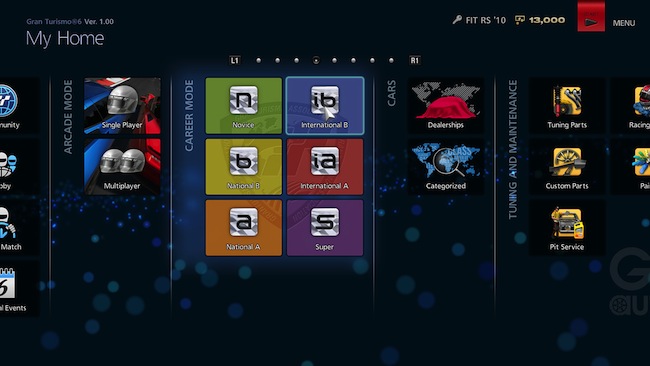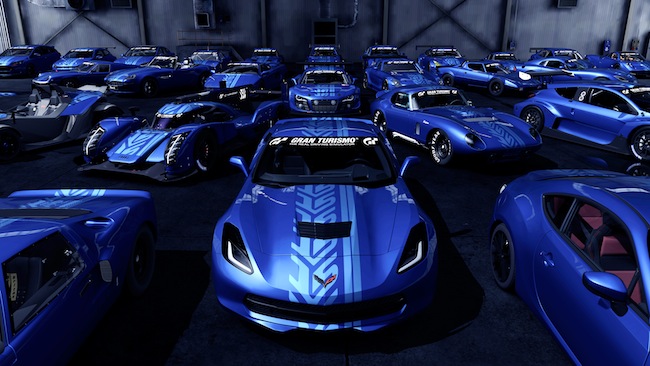
Refusing the design mentality of the arcade racer, yet wanting to release to a larger audience than engineers in need of a hardcore simulator, racing sims are a niche of niches. Thankfully, Gran Turismo has been a perfect entry point, maintaining the complexity for the veterans while simplifying the intimidating simulation into a game format for newcomers… Like me circa a few years ago. I was first introduced to Gran Turismo 5 by a friend through the brute force method of constantly playing it with him, which I was reluctant to do at first but slowly accepted as inevitable. I’ve slowly come to appreciate the game as an invaluable tool to vent my inner “douchebag driver” while slowly learning about novel concepts such as driving lines, cornering, and terrible user interfaces.
Gran Turismo 5 was a great game once you got into it, but getting in was almost a game in itself. For some insane reason, every choice presented to you was in the form of a list, and loading screens were an absolute nightmare. As such, you can imagine both mine and my friend’s excitement upon hearing about the revamped GT6 interface, a new suspension model, a new chance for GT to trump Forza once again as king sim. Well, his excitement at least; I couldn’t pretend I was as into GT as he was. Still, I was intrigued if the changes could more easily bring newcomers into the GT world instead of having to be brute forced to finally enjoy the sport of racing.

As is to be expected from a sim game, the story is more like a series of inferences than a plot. When you first start the game, you’re thrust into a tutorial that guides you through the basics of racing, buying your first car, and how to progress to higher-tier races. As you make your way through career mode, you’ll start having to prove yourself through licensing qualifiers in order to drive amongst more interesting and faster cars. The game never tells you that you’re an amateur driver trying to make a name for yourself or that you’re an experienced driver who was exiled and must rise through the ranks once more; instead implying that you’re just another driver steadily gaining experience to race in more competitive settings. The biggest clue you’re ever given is your avatar wearing a racing suit and a helmet, which isn’t really indicative of much apart from suggesting that you’re a bit pro.
GT is a game of self-improvement, passion for racing, and professionalism over outright competition. There are seasonal events that update monthly, and online leaderboards exist, but nothing exists to create a story. You’re never presented with an in-game rival or external motivation for making your way forward, relying more on your inner drive (pun totally intended) to keep you interested in trying new cars and overcoming challenges. The progression is quite swift too, enabling you to start driving super cars such as the Ferrari 458 Italias within an hour or two of playing, but it still might feel like a superfluous grind if all you wanted was a sandbox to test cars in.

While players are essentially free to do whatever they want after the initial tutorial, the beginning of the game is very railroading. The first car you buy is chosen for you, you make little to no money for each race, and the multiplayer is locked until you qualify for the third tier of career mode. It’s not a game breaking flaw, and it certainly helps newbies to get a grasp on how to properly handle a vehicle, but given that many people who play Gran Turismo 6 (myself included) have already played Gran Turismo 5, and the cars still handle like cars, it can feel stifling to be forced to learn how to drive again all over again. However, with that being said, once you get into the higher tier races, you’ll start earning more than enough money to afford any car you could possibly want.
While many improvements have been made since it’s predecessor, Gran Turismo 6 still has a lot of strange issues that plague the experience. The most significant changes lie in the updated menu system, removing excessive loading screens and tedious lists from previous GT titles, streamlining everything from car selection to lobby creation into grids for maximum convenience; well, most of the time. Most menus will be presented in grid form, allowing you to skip past a significant number of options with L1 and R1, but other menus will still give you a list that you have to scroll through one item at a time (including browsing all the cars in your garage). Similarly, you’re forced to start watching a replay after every race in career mode, which gets annoying very quickly. The post-race menu from Gran Turismo 5 has remained unchanged (meaning you’ll have to scroll past about 5 options before you can exit), and you still have to turn traction control off for individual cars when you race with them. They might only be a few minor annoyances, but they add up and disrupt the flow enough to be noticeably frustrating.

Although, in saying that, I feel that these issues are somewhat understandable when you stop and take into consideration just how much content has been crammed into the game. Upon writing this review, there are 1,211 cars, with the promise of more to come. There are supercars, classic cars, concept cars, Le Mans, NASCAR, and even go-karts, all licensed by manufacturers ranging from Honda and Ford to Mercedes and Lamborghini. Just about any car you’ll want to drive is somewhere in the line up, but this also acts as a hindrance. Some cars, like the MX-5 or RX-7, have multiple models with identical specs, cost, and in-game rating, but were included because they were released as separate models. While I can appreciate the attention to detail, this does add unnecessary clutter into an already spectacularly full line up of cars, and if you didn’t know much about cars to begin with, the intimidation factor feels somewhere between pure unadulterated terror and an extended edition LotR marathon.
With as many cars available as there are in the game, restrictions on what cars you have to use in a particular race are often more lenient than they should be. Most events will specify cars below a particular in-game rating, which means you can take a car at the very limit of that rating and wipe the floor with your opponents ruptured oil tanks. Races that enforce a specific car model somewhat level the playing field and provide a much more meaningful challenge since no one’s using a kitted out monster that’s barely legal to race, but they are few and far between, usually being given as side-races that don’t reward the player in-game. You may feel an inner obligation to race with a recommended car, but why would you when you could nab an easy victory and progress faster? Regardless of what car you pick, you’ll still be able to customise it like crazy before hitting the race track.

Where previously there has been a functional difference between ‘premium’ and ‘standard’ cars, everything you own can now have tires replaced, suspension modified, and be generally spruced up. There’s a plethora of options available to you, and a lot of effort has clearly gone into giving you very tight control over how to tune your car. The new suspension model is especially well implemented, allowing for very precise control over spring rate, dampening, and camber before a race. If you don’t know anything about cars, you might not utilise everything to it’s full extent, but for car enthusiasts, it’s a haven of specificity and experimentation. There’s still no significant damage model, simulating tyre wear and oil usage, but lacking consequences for driving into walls. It fits the game’s tone and is easy to overlook given what’s on offer, but also hard to look past given the realism.
When it comes to the tracks, there are currently 71 layouts (in 37 unique locations) that have traits including variable weather, reverse racing direction, and the moon. Yes, the moon. You’ve got classic raceways such as Nürburgring and Bathurst along with original tracks like Eiger Nordwand, and while GT6 might not have the hyper-insane levels of realism of track modelling iRacing is renowned for, it comes pretty bloody close. You also have wackier places like go-kart tracks and lunar missions. I was a little disappointed that there weren’t more places for my rover to traverse, but the more novel events were a great distraction from the all the typical races.
It’s obvious that the prime focus of the game was placed into making cars feel like cars, and that’s exactly what GT6 does. It’s what made Gran Turismo what it is, and if anything it’s simply been improved through the addition of the new suspension model and new cars. Whether you’re using a controller or a wheel, the controls are exactly as you’d imagine and vary significantly depending on what car you’re driving. No amount of pushing that stick to the left is going to fix your car’s understeer, and just hammering the brakes mid corner is most definitely going to make you skid out. However, if you’re thinking of buying GT6, I’d highly recommend bundling it with a wheel.

Besides the obvious argument that cars should be driven using wheels and not thumb sticks, Gran Turismo 6 has very clearly been designed with a wheel in mind. The controller works just fine, but lacks the same feedback that is provided by the wheel, including vibrating when braking, accelerating, or doing literally anything. In my opinion, this greatly detracts from the driving experience since any feedback that would be expected through the controller is only supplied through the resistivity of the wheel. Getting a wheel also allows much finer control in steering, braking, acceleration, and overall control of cars. You’ll certainly feel ballsier with a controller, offering a certain level of disconnect between you and the car, but I found myself returning to the wheel as the preferred interface. Unfortunately, no matter how well you control your vehicle, you still have no control over the AI.
To say the AI in Gran Turismo is a little brain dead would be like calling cricket mildly uninteresting. The AI feels as if it’s been coded to follow a line, and that line only, because they’re almost totally unreactive to your movements. You can swerve all around them and only be blocked one tenth of the time. I understand that aggression in real racing is not a great way of getting ahead, but blocking is still a legitimate move to make. It can be equally frustrating when you are blatantly, but unintentionally, rammed by an AI driver or vice versa; making you question how these theoretical drivers past the qualifiers. If you drive as the AI expects you to drive, they function as you would expect, but anything beyond that and you’ll be facepalming at the idiocy of these terrible drivers.

The opening cinematic makes it abundantly clear that cars are shiny. Very, very shiny. GT6 is graphically stellar, practically rivalling next-gen graphics with 7-year old hardware, but can be a bit hit-and-miss at times. Most cars look fantastic, realistically reacting in accordance with the new suspension model and really showing off their insane detail in photo mode. The menus are sleek and minimalist, and the tracks looks great, but the surroundings and the occasional car model will be somewhat underwhelming. The game has clearly been heavily optimised to run on the old hardware, resulting in very selectively placed high res textures and beautifully detailed cars juxtaposed against simplistic backgrounds and horrible water effects. Some cars are still classified as ‘standard’, meaning their models are jarringly low res compared to ‘premium’ cars, especially in photo mode. You definitely won’t notice it mid-race unless you really keep an eye out for it. Overall, it’s a great looking game.
The top-notch graphics in GT6 are accompanied by top-notch sound design. Each car’s engine thrums, purrs, or (in the go-karts’ case) squeals with a full presence; tyre’s screech adaptively with your movements, and you’ll hear each component of your car work as you drive. Sadly, the same can’t be said of the music, which is about as enjoyable as having my ears joyously scrubbed with a rusty nail. It’s an inconsistent mess of a soundtrack, flirting with elevator music before shifting into the bold territory of cheesy-trying-to-sound-edgy rock. Thankfully, you can replace it with your own music, or turn it off entirely and enjoy the sounds of racing as they would be in real life.
 New user interface is vastly improved
New user interface is vastly improved Updated suspension model is great
Updated suspension model is great Incredible graphics for the PS3 platform
Incredible graphics for the PS3 platform Outstanding attention to detail
Outstanding attention to detail Provides nice introduction to racing
Provides nice introduction to racing Still some lingering menu issues
Still some lingering menu issues AI is unreactive and predictable
AI is unreactive and predictable Analog controls feel underdeveloped
Analog controls feel underdeveloped Sometimes detailed to a fault
Sometimes detailed to a faultWhile I’m a bit disappointed that a few of the lingering issues from its predecessor are yet to be fully resolved, Gran Turismo 6 is still an overall improvement in almost every respect. With a cleaned up UI, insanely detailed graphics and a updated physics model, the game offers something for new and old players alike. It’s certainly fine to play with a controller, but it’s much more aimed at racing enthusiasts who want to feel the resistance of a wheel in their hands as they drift around a corner, tyres screeching, and the engine crying. With that being said, it’s still a difficult game to get into, but the changes have made it a hell of a lot easier, and a hell of a lot quicker too. A bit of brute force might still be required to really get into GT6, but it’s one of the best racing sims out there.











